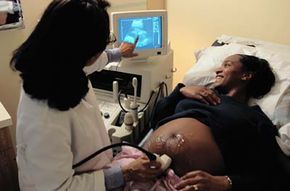Ectopic Pregnancy
Ectopic (out of place) pregnancy occurs when the fertilized egg develops outside the uterus. The most common location of ectopic pregnancy is in one of the fallopian tubes (structures that extend about 41/2 inches from the ovaries to the uterus and through which the egg travels from the ovary to the uterus). An ectopic pregnancy that occurs in a fallopian tube is called a tubal pregnancy. On rare occasions, the pregnancy starts to develop in the ovary, on the cervix, or attached to the surface of a nearby organ.
An ectopic pregnancy is one in which the fertilized egg develops outside the uterus. One out of every 100 to 150 pregnancies is ectopic, most often in the fallopian tubes, but also in the ovary, on the cervix, or attached to another organ in the abdominal cavity.
Advertisement
Causes
The usual cause of ectopic pregnancy is an obstruction or narrowing of a fallopian tube that prevents the fertilized egg from passing through the tube into the uterus. This obstruction or narrowing is sometimes the result of inflammation and scarring from a previous pelvic infection caused by a Gonococcus or Chlamydia infection. Tubal infections caused by numerous other bacteria can also occur after miscarriage, after childbirth, or during the use of an IUD (intrauterine contraceptive device). If these infections are severe, blockage or narrowing of the tube may result.
Other less common causes of tubal obstruction or blockage include abdominal infections, such as appendicitis; pelvic tumors; and scar tissue formation after abdominal surgery.
Complications
An ectopic pregnancy may be fatal unless it is promptly treated. Left undetected it can rupture the tube enclosing it, leading to profuse bleeding into the abdomen. Ectopic pregnancies located in other areas, such as the ovary and cervix, can invade nearby blood vessels and cause massive bleeding. In earlier years, ectopic pregnancy was catastrophic, often leading to death. Today, with the advent of safe blood transfusions and better diagnostic methods allowing early diagnosis, death resulting from ectopic pregnancy is uncommon.
Symptoms
Symptoms of ectopic pregnancy usually appear two to four weeks after a woman has missed her menstrual period. Irregular spotting of blood from the vagina is one of the earliest symptoms. This is frequently followed by sharp, continuous pains on one side of the lower abdomen.
If the ectopic pregnancy ruptures, the woman usually experiences sudden, sharp, severe pain in the lower abdomen accompanied by rapid heartbeat and backache and, in some cases, fainting. However, the woman may experience no unusual symptoms even up to the point of rupture.
Diagnosis
During a pelvic examination, the doctor may discover a tender swelling on one side of the pelvis. Movement of the uterus or ovaries during this examination may cause pain. If there is a high suspicion of ectopic pregnancy, the woman is immediately hospitalized.
When an ectopic pregnancy is a possibility, an ultrasound of the pelvic structures may reveal the location of the ectopic pregnancy. Blood that has leaked from the ectopic pregnancy into the abdominal cavity may be detected by inserting a hollow needle through the wall of the vagina beneath the cervix and drawing off blood or by an examination using a pelvic ultrasound. The diagnosis is confirmed by inserting a laparoscope (a lighted, tube-like instrument) into the abdominal cavity through a small incision made below the navel. This allows the doctor to look directly at the pelvic organs and precisely locate the ectopic pregnancy.
Treatment
Treatment for ectopic pregnancy depends on several factors, including the size of the embryo and whether it has caused a rupture or not. If the embryo is small and the woman is not experiencing significant pain or bleeding, ectopic pregnancy may be treated using methotrexate, a drug that interferes with the growth of the embryo and causes it to be reabsorbed into the body.
Methotrexate is administered as an injection, and the woman must be closely monitored for complications and success of the treatment. If the treatment fails, the embryo is large, or the woman is experiencing significant pain or bleeding, surgical removal is necessary.
A woman who has had one ectopic pregnancy has a 15 percent chance of having a second one. This does not mean she should not try to become pregnant again, but when she does try, she should be especially watchful for symptoms of ectopic pregnancy. She should see her doctor as soon as she suspects she is pregnant so the location of the embryo may be determined.
Even if the embryo develops normally, the pregnancy can still end in tragedy. On the next page you'll learn about the factors that lead to a stillbirth.
